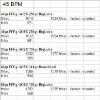I took the Walker out today to do a test drive of the new chrony. I fired quite a few rounds through the Walker today...both .45 Colt and .45 BPM. The results posted here are very preliminary. I had the Walker sitting back 15 feet from the chrony. When I got up to the 52 grain .45 BPM rounds I started having quite a bit of difficultly with unrecorded/error reports. I had thought it was the position of the sun causing all the problems but I confirmed it was the big loudenboomers. When I dropped back to firing .45 Colt rounds everything was recorded fine. Next time I go out I'm gonna drop back another 5 feet to 20 feet total.
I wouldn't try to draw any conclusions based on these results. They are mostly posted for grins. I need to go back and analyze the results a bit more. Mostly, I just need to get back out there and fire more rounds.
The .45 BPM is fairly respectable. However, I see how it is that the .357 Magnum took the cake in 1934 with that heathen powder.

I wouldn't try to draw any conclusions based on these results. They are mostly posted for grins. I need to go back and analyze the results a bit more. Mostly, I just need to get back out there and fire more rounds.
The .45 BPM is fairly respectable. However, I see how it is that the .357 Magnum took the cake in 1934 with that heathen powder.











